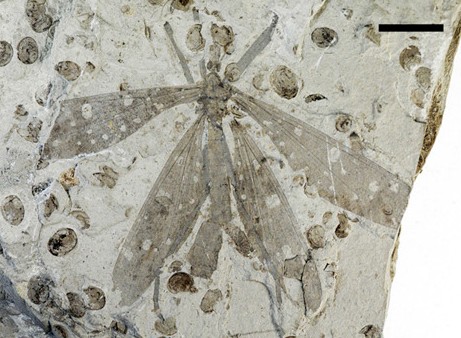Hangingfly Mimicked Ginkgo-like Leaf in China’s Jurassic Period
A new species of hangingfly with wings that perfectly mimic the leaf of an ancient ginkgo-like tree has been discovered in China by scientists at the Smithsonian, the University of Maryland and the College of Life Sciences at Capital Normal University in Beijing. Fossils of both the insect Juracimbrophlebia ginkgofolia, and the ginkgo-like tree, Yimaia capituliformis, were exquisitely preserved in 165 million-year-old sediments dating from the Middle Jurassic period.
“The mimicry is so amazing that some 165 million years later it even fooled me as I was examining fossils from the field and at the lab in China,” said Conrad Labandeira, paleobiologist at the Smithsonian’s National Museum of Natural History and co-author of a paper on the discovery in the Proceedings of the National Academy of Sciences USA. Hanging down by its long forelegs from the bottom of a leaf petiole, the four long wings and body of J. ginkgofolia would have perfectly matched the five hanging lobes of a single ginkgo-like leaf.
Hangingflies are a subset of scorpionflies with long legs, narrow wings and a thin body about 1.5 inches long. J. ginkgofolia was found in deposits of the Jiulongshan Formation at Daohugou Village in northeastern China’s Inner Mongolia, and it represents a new genus and species.
J. ginkgofolia’s shape and form most likely attracted smaller insects that fed upon the leaves of the ginkgo-like plant, which J. ginkgofolia would catch and eat. In this way the insect benefited from a reciprocal relationship with the tree, a relationship that the fossils indicate lasted about 1 million years. The ability of these insects to hide in plain sight upon the leaves of the tree also helped them avoid predators.
“This discovery is important because it is a rare example of insect mimicry modeled on a gymnosperm and not a flowering plant,” Labandeira said. “Virtually all of today’s examples of insect mimicry are modeled on flowering plants, the angiosperms. J. ginkgofolia, however, lived about 45 million years before the appearance of flowering plants, so this discovery gives us better idea of the early relationships between gymnosperms and this hangingfly insect group.” Although the ginkgo-like Y. capituliformis occurs in other geologic deposits, the hangingfly has not, Labandeira said. “They both probably went extinct at the end of the Jurassic.”
# # #
SI-521-2012
“Jurassic mimicry between a hangingfly and a ginkgo from China,” by Yongjie Wang, Conrad C. Labandeira, Chungkun Shih, Qiaoling Ding, Chen Wang, Yunyun Zhao and Dong Ren, Proceedings of the National Academy of Sciences USA, volume 109.
Link to article: www.pnas.org/content/early/2012/11/21/1205517109.full.pdf.

